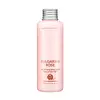What's inside
What's inside
 Key Ingredients
Key Ingredients

No key ingredients
 Benefits
Benefits

No benefits
 Concerns
Concerns

 Ingredients Side-by-side
Ingredients Side-by-side

Dipropylene Glycol
HumectantEthylhexyl Palmitate
EmollientButylene Glycol
HumectantHydrogenated Polydecene
EmollientCetyl Ethylhexanoate
EmollientCyclopentasiloxane
EmollientGlyceryl Stearate
EmollientPEG-100 Stearate
Butyrospermum Parkii Butter
Skin ConditioningDimethiconol
EmollientWater
Skin ConditioningRosa Damascena Flower Water
MaskingPhenoxyethanol
PreservativeHelianthus Annuus Seed Oil
EmollientRosa Hybrid Flower Extract
Skin ConditioningLilium Tigrinum Extract
Skin ConditioningIpomoea Purpurea Extract
Skin ConditioningCentaurea Cyanus Flower Extract
AstringentBorago Officinalis Extract
EmollientViola Mandshurica Flower Extract
AntioxidantSyringa Vulgaris Extract
Skin ConditioningCamellia Japonica Flower Extract
EmollientChrysanthemum Sinense Flower Extract
CleansingHelianthus Annuus Flower Extract
Skin ConditioningNarcissus Pseudo-Narcissus Flower Extract
Skin ConditioningPrunus Serrulata Flower Extract
Skin ConditioningPrunus Armeniaca Fruit Extract
Skin ConditioningNelumbo Nucifera Flower Extract
Skin Conditioning1,2-Hexanediol
Skin ConditioningGlycerin
HumectantAloe Barbadensis Leaf Extract
EmollientSodium Lactate
BufferingSodium Gluconate
Skin ConditioningPolysorbate 60
EmulsifyingSodium Hyaluronate
HumectantCetearyl Alcohol
EmollientSorbitan Sesquioleate
EmulsifyingStearic Acid
CleansingAcrylates/C10-30 Alkyl Acrylate Crosspolymer
Emulsion StabilisingParfum
MaskingPotassium Hydroxide
BufferingXanthan Gum
EmulsifyingDisodium EDTA
BHT
AntioxidantDipropylene Glycol, Ethylhexyl Palmitate, Butylene Glycol, Hydrogenated Polydecene, Cetyl Ethylhexanoate, Cyclopentasiloxane, Glyceryl Stearate, PEG-100 Stearate, Butyrospermum Parkii Butter, Dimethiconol, Water, Rosa Damascena Flower Water, Phenoxyethanol, Helianthus Annuus Seed Oil, Rosa Hybrid Flower Extract, Lilium Tigrinum Extract, Ipomoea Purpurea Extract, Centaurea Cyanus Flower Extract, Borago Officinalis Extract, Viola Mandshurica Flower Extract, Syringa Vulgaris Extract, Camellia Japonica Flower Extract, Chrysanthemum Sinense Flower Extract, Helianthus Annuus Flower Extract, Narcissus Pseudo-Narcissus Flower Extract, Prunus Serrulata Flower Extract, Prunus Armeniaca Fruit Extract, Nelumbo Nucifera Flower Extract, 1,2-Hexanediol, Glycerin, Aloe Barbadensis Leaf Extract, Sodium Lactate, Sodium Gluconate, Polysorbate 60, Sodium Hyaluronate, Cetearyl Alcohol, Sorbitan Sesquioleate, Stearic Acid, Acrylates/C10-30 Alkyl Acrylate Crosspolymer, Parfum, Potassium Hydroxide, Xanthan Gum, Disodium EDTA, BHT
Ingredients Explained
These ingredients are found in both products.
Ingredients higher up in an ingredient list are typically present in a larger amount.
Parfum is a catch-all term for an ingredient or more that is used to give a scent to products.
Also called "fragrance", this ingredient can be a blend of hundreds of chemicals or plant oils. This means every product with "fragrance" or "parfum" in the ingredients list is a different mixture.
For instance, Habanolide is a proprietary trade name for a specific aroma chemical. When used as a fragrance ingredient in cosmetics, most aroma chemicals fall under the broad labeling category of “FRAGRANCE” or “PARFUM” according to EU and US regulations.
The term 'parfum' or 'fragrance' is not regulated in many countries. In many cases, it is up to the brand to define this term.
For instance, many brands choose to label themselves as "fragrance-free" because they are not using synthetic fragrances. However, their products may still contain ingredients such as essential oils that are considered a fragrance by INCI standards.
One example is Calendula flower extract. Calendula is an essential oil that still imparts a scent or 'fragrance'.
Depending on the blend, the ingredients in the mixture can cause allergies and sensitivities on the skin. Some ingredients that are known EU allergens include linalool and citronellol.
Parfum can also be used to mask or cover an unpleasant scent.
The bottom line is: not all fragrances/parfum/ingredients are created equally. If you are worried about fragrances, we recommend taking a closer look at an ingredient. And of course, we always recommend speaking with a professional.
Learn more about ParfumWater. It's the most common cosmetic ingredient of all. You'll usually see it at the top of ingredient lists, meaning that it makes up the largest part of the product.
So why is it so popular? Water most often acts as a solvent - this means that it helps dissolve other ingredients into the formulation.
You'll also recognize water as that liquid we all need to stay alive. If you see this, drink a glass of water. Stay hydrated!
Learn more about Water